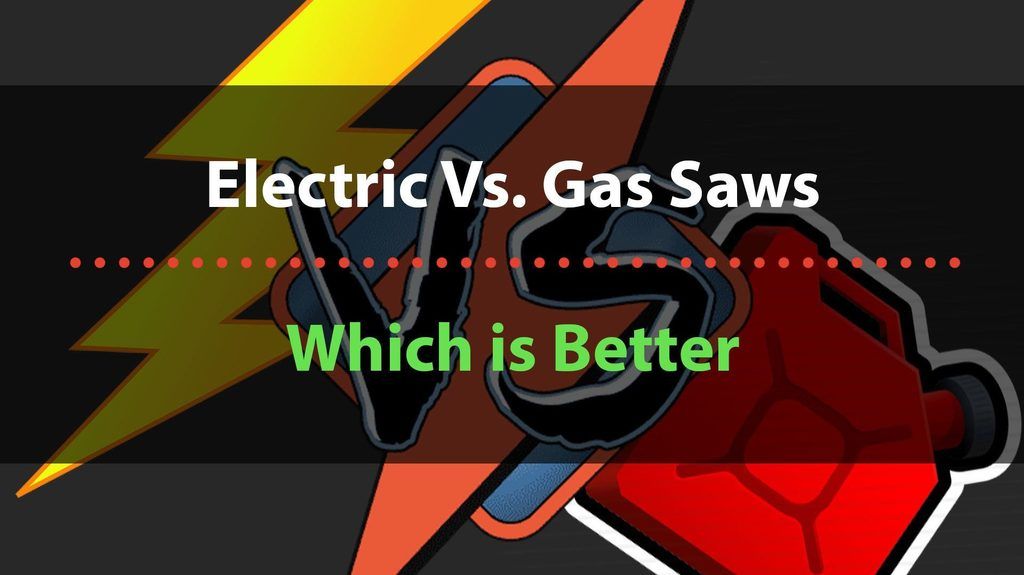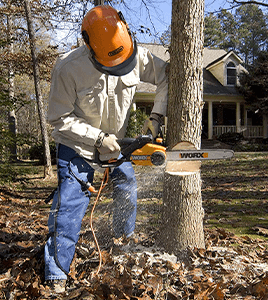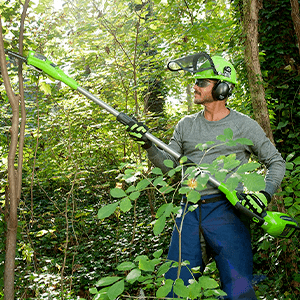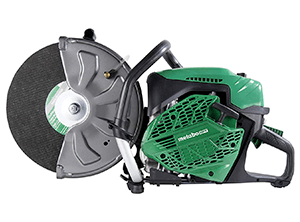
Electric Vs Gas Saws – Which is the Right One for You?
There are many things that you may need to take into consideration when looking for the perfect saw. If you are wondering which is better, an electric or gas-powered saw, then this might be the article for you.
Within this article, we will be covering the general differences between all, electric and gas-powered tools. These comparisons can apply to all power tools, chainsaws, cutoff saws, and pole-saws, that can come in both gas or electric-powered varieties.
The differences that we will be comparing boil down to size, weight, noise, performance, and even convenience as well as ease of use. While a cutoff saw is fundamentally different from a pole-saw, the pros and cons can still be the same.
Budget
The first thing that most people want to look at is how much money the saw will cost them. This isn’t so much to do with just the initial outlay for the saw; there’s also the ongoing running costs, as well as servicing and repair costs to consider as well.
Running costs
Electric saws, both the battery-operated cordless saws and power corded saw, are powered by electricity. This doesn’t mean that they cost the same amount to run, however.
Battery Packs
Battery operated cordless tools use lithium-ion batteries as their power source. These batteries are relatively cheap to charge, but they can only hold a limited charge. So if you intend to use the saw for longer than what the battery(s) can sustain, then you’re going to need an additional battery or two.
- Lithium-ion batteries could set you back $30 – $100.
- They can come in sizes: 18v, 20v and 60v. The larger the voltage, the more expensive the battery.
- Charging stations are needed to recharge the batteries. The cheaper stations are designed to charge one battery at a time. The more expensive stations can be used to charge multiple battery packs at the same time.
Power Source
Direct electricity is the cheapest running cost option available for power tools. The trade-off is that in order to use a saw with a power cord; you will need to have access to a suitable power source that the power cord can be plugged into at all times.
- You will need to use an extension cord that’s long enough to allow you to reach the area you want to be working in.
- If you want to use the saw at a location that does not have access to a suitable power supply, then you are going to need a portable generator that’s strong enough to power your saw.
Gas/Fuel
Of the three different power sources, gas-operated saws have the most expensive running cost. What makes gas a more expensive fuel source is that:
- Gas prices are not as stable as electricity.
- A 2 stroke fuel additive may be needed.
- Fuel can evaporate when either stored on a shelf or left in the tank.
Parts, Repairs, and Servicing
When it comes to maintaining your tools, there’s a big difference between electric tools and combustion engine based tools. Unless you actually know what you’re doing, it is not wise to be fiddling around with the internal components of any electric tool. If you expose a wire or rewire them wrong, not only do you run the risk of the saw not working, it could lead to injury from electric shock.
This is not to say that you can’t clean or replace the physical components of the saw. But when it comes to the electrical aspects, it could be more advisable for you to have your tools serviced by a professional. Some parts may not be replaceable, or available for purchase. So if you need to replace a part that can’t be bought, you may need to cannibalize the parts from another saw that’s of the same model.
Whereas, combustion engine tools are much easier to service and repair by yourself. Even if you are new to working on engines, it is something that can be easily picked up. There are lots of user manuals and shared information online, with most parts being universal and easily found.
Initial Outlay
The initial cost of the saw could be the deciding factor for which type of saw you might want to buy. For those of you who are wondering which would be the cheapest or most expensive saw type, here is a brief breakdown of the price disparities for the same sized saws.
The cheapest saws on the market, are the corded electric saws.
They come complete, without requiring any additions parts whatsoever, well excluding the blade or chain in some cases that is. Corded saws don’t have many overly complicated components. All that they require to operate is a suitable power supply.
Gas-powered saws are the mid-range priced saws.
Like the corded saw, gas-powered saws come ready to run. You may need to buy the chain or blades separately, but unlike the cordless saws, you don’t need to buy any additional power sources. Just be sure to use the correct type of gas for the saw.
What makes cordless saws the most expensive?
Not every power tool that uses a battery is sold with one. Most are sold, tool only, or “bare” as it is also known. This means that you will need to buy the battery and charging station separately from the saw itself. Or you may need to purchase a stronger battery. This could be because the battery that came with the saw might be their weakest model, or you might need a backup battery for the bigger jobs.
Noise and Smoke

One of the most noticeable differences between electric saws and gas-powered saws is with how much noise, and smoke that they can produce. Electric saws are a lot quieter than gas-powered saws while they are cutting through material. Nor do they have any idling noises, or produce any exhaust smoke.
Gas-powered engines, on the other hand, continuously idle after they’ve been turned on. This idling makes a rumbling noise and produces smoke, even when the engine isn’t being revved. When the blade is engaged, the engine powers up, creating even more noise and blowing out more smoke. For this reason, it is best to use gas-powered saws in open, well-ventilated areas.
Size and Weight
Both styles of saws, electric and gas, can still use the same sized blades or chains as each other. The differences that can be seen are in the body casing itself. Electric saws have a slender, more streamlined design, while gas-powered saws tend to have a more bulky, cumbersome design.
Corded Electric Designs

Corded electric saws tend to have the most balanced and sleekest designs. They are lighter and can be more compact than even similarly designed cordless saws.
Cordless Designs

Cordless saws have been designed with specific battery packs in mind. To operate some of these saws, they may require 2 battery packs that are positioned on top of the saw. Others may only need one battery, which is inserted underneath or at the back end of the tool.
Using the intended battery packs helps to keep the saw feeling well balanced and not too heavy. Some of these saws can use off-brand batteries, but doing so can make the saw more cumbersome, feel off blanded, or even heavier to hold.
What this means is that if you were to switch out the batter for a different brand, it could throw off the balance of the saw a little. If the shape or size of the new battery pack is different enough, it may get in the way of the gripping handle, or protrude too much to the side.
Gas Powered Designs

Gas-powered saws have combustions engines that power and drive their chains or blades. They also require a fuel tank, pullcord, and shutoff valve. This makes designing sleek looking gas-powered saws difficult to do.
If the tank is too small, it will not be able to contain enough gas for an acceptable run time. But if the tank was too big, it will become too cumbersome and add unneeded weight. Due to these design limitations, and additional components, gas-powered saws are the heaviest and most cumbersome saws on the market.
Performance
Electric saws have come a long way over the years. Thanks to technological advances, electric saws are now more powerful and more efficient than ever. This makes giving a general performance comparison rather difficult to do, even if we were only comparing chain saws, for example.
Most cordless saws and gas-powered saws are almost neck and neck in comparison. Fully charged cordless saws can be just as powerful as most gas saws. They can cut through the same materials, just as smoothly, and can use the same types of chains, blades, or disks without issue.
Where cordless saws lose out against gas-powered saws, is when their battery(s) are running low on power. When a gas saw runs low on fuel, they don’t lose any power and continue to perform the same until there’s no more gas left in the tank. Whereas a cordless saw could have enough juice left in the battery to rev up the saw when the trigger is pulled, only to seize up once it tries to cut through the material.
Corded saws may not be as powerful as the gas or cordless saws, but as long as they are connected to a power source, their performance is consistent and doesn’t falter by the end of the day. That is as long as they are not allowed to overheat. Avoid trying to cut through materials that are too dense for them to handle, and give them time to cool down between cuts.
Convenience and Ease of Use
All three of the saw types have their own strengths and weaknesses, which makes them better suited for some situations but not others. You may want to consider what you need the saw for, more than how much so then how much it’s going to cost you to buy and maintain it.
Corded Saws
Corded chain saws and pole saws are better suited for the odd jobs around the house. Or for smaller tasks like trimming branches, or cutting firewood. They are arguably the quietest of the three options, produce no exhaust smoke, whatsoever, and is the lightest of the designs.
Heavy-duty power saws and cutoff saws work great in factory settings. Not so much onsite. The additional power cords can become a trip hazard if not properly managed.
The fact that they require a suitable power source to be plugged into makes corded saws less viable for onsite or outdoor work. As we mentioned earlier, you can get around this by using long enough extension cords, and/or by having a portable generator with you.
The generator will need to consume fuel, however, so this means that a gas saw may very well have been a better option. Furthermore, the direct connection to a high voltage power supply makes corded tools dangerous to use outside in the rain. This means that corded saws are not an ideal tool to be for emergency storm clean-ups, or for use in wet areas.
Cordless Saws
Quiet, clean, and portable. What more could you ask for, right? While battery-operated tools can be highly versatile, they can still have their drawbacks.
The greatest strength that a cordless saw has just so happens to be its greatest weakness as well, the battery. I know it sounds highly contradictive, but hear me out.
The batteries that these types of tool use, allows them to be taken almost anywhere, and safely used in various positions, including upside down and tilted left or right. This makes them a very portable tool indeed, and if they happen to be cared for properly, they can even be used outdoors in the pouring rain to clear fallen trees off of the road. I know it sounds great; am I right.
But where the battery becomes their downfall, is with how they only have a limited power supply and take time to recharge. You could get around this hurdle by buying more batteries and keeping some backups on hand. But have you ever tried carried multiple batteries around?
Storing them in tool chests, along the wall, or on the workbench is one thing. But carrying them around with you is something else. Not every worksite can be easily accessed by car, and some sites may require you to carry your tools in.
Batteries are surprisingly heavy for their size and awkwardly shaped. They have even been known to get damaged when they’ve been carried around in backpacks or loosely packed into toolboxes. So even if the batteries were fully charged, having a damaged battery on you would be no different from just having another flat battery.
Gas Saws
The old school tried and tested chainsaws, and pole saws just can’t be beat, well not yet at least. Comparing these types of saws to their cordless counterparts is simply a matter of endurance.
While the electric saws may be lighter and less cumbersome, they can run out of juice faster than most gas-powered saws. This basically means that these more traditional tools are able to make more cuts over a longer period of time.
Combustion engines are easier and safer to service and repair yourself, as long as you have the appropriate knowledge that is. They also tend to be more durable and can be operated for longer periods of time before overheating.
Unlike the cordless saws, gas saws can be quickly refueled as many times as it takes to empty the gas can. If you are working off-grid, or need to travel a fair distance from a power source, these combustion engines need only a gas can or two to keep them topped up for the day.
This doesn’t mean that gas saws are without faults:
- They are very noisy, even making noise while idling.
- They produce a lot of smoke, which makes them hazardous for use in small spaces.
- Depending on the model you are using, some can’t be tilted or angled in certain ways, as it can cause the gas to leak out of the cap.
- Gas saws are bulky and can weigh more than other saws.
- The engine itself may take a while to overheat, but it nevertheless becomes hot to the touch and can leave 2nd or 3rd-degree burns if mishandled.
- As most gas saws use a pull start to crank the engine, they can be hard to start sometimes.
- Gas/fuel is a hazardous substance. If handled or stored inappropriately, it can lead to leakage or fires.
- If the gas is contaminated with water, or improperly mixed, it could cause the engine to sputter or even seize.
- As gasoline ages, it evaporates and can spoil, which makes storing gas for long periods of time impractical.
Final Thoughts
Picking the saw that’s right for you can be hard if you’re not experienced with using these types of tools. What we suggest would be for you to consider where you’ll be using it, and for how long.
If you want to use the saw for the odd job around the house and you live close to your neighbors, you might want to consider using either of the electric saw varieties to help keep the noise down.
If you are worried about your carbon footprint or want to keep your costs down, then a corded saw might be the right choice for you.
For jobs that are off-grid, gas saws can be more convenient, but they weigh more than most of the cordless saws. On the other hand, the batteries needed to power a cordless saw could make bringing a cordless saw with you impractical.
